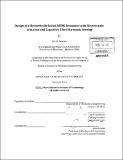Design of a hermetically sealed MEMS resonator with electrostatic actuation and capacitive third harmonic sensing
Author(s)
Newton, Eric B
DownloadFull printable version (17.78Mb)
Other Contributors
Massachusetts Institute of Technology. Dept. of Mechanical Engineering.
Advisor
Carol Livermore.
Terms of use
Metadata
Show full item recordAbstract
A microscale beam resonator has been designed and fabricated for use as a modular pressure sensor for vacuum applications. The device dimensions have been optimized to provide measurable signals with low noise. Electrostatic actuation and sensing are both performed using only one pair of electrodes. The motion of the cantilever changes the capacitance of the actuation electrodes at a frequency three times that of the actuation signal. This method allows the desired motion to be picked out using a lock-in amplifier with minimal interference from other unwanted signals such as parasitic leakage and noise. Unlike previous work, packaging and electrical contacts have been integrated into the fabrication to create a hermetically sealed device that can easily be incorporated into other MEMS designs. Most resonators operate in vacuum because air damping at higher pressures greatly decreases both resonant frequency and quality factor. This loss is directly related to the pressure of the surrounding air, and therefore has been used in this design to measure the pressure. While the relationship is not linear, it is one-to-one. This means that once the device has been characterized, pressure can be determined uniquely over a range from atmospheric pressure down to ~10- Torr. The device was fabricated from two SOI wafers using standard wafer processing techniques. This means that unlike previous work, it can be readily integrated into other designs via wafer bonding. A single access port on the base provides a connection between the otherwise hermetically sealed sensor and other devices. To prevent squeeze film damping from limiting the motion of the beam, the cantilever tip has been perforated with an array of holes and a cavity was etched above where the cantilever will oscillate. Electrical contact can easily be made with the device as fabricated, so no additional packaging is necessary. While the fabricated devices are hermetically sealed, resonance was never detected due to a combination of factors including: poor wafer bonding, parasitic leakage, a Schottky barrier at one terminal and a design error that led to an unexpectedly high frequency and quality factor. Modifications to the current design are proposed that should eliminate these problems in the next iteration.
Description
Thesis (S.M.)--Massachusetts Institute of Technology, Dept. of Mechanical Engineering, 2012. Page 146 blank. Cataloged from PDF version of thesis. Includes bibliographical references (p. 138-140).
Date issued
2012Department
Massachusetts Institute of Technology. Department of Mechanical EngineeringPublisher
Massachusetts Institute of Technology
Keywords
Mechanical Engineering.